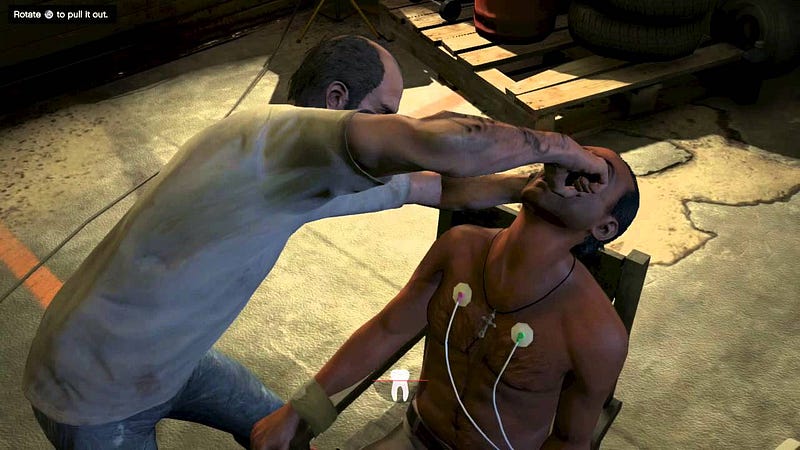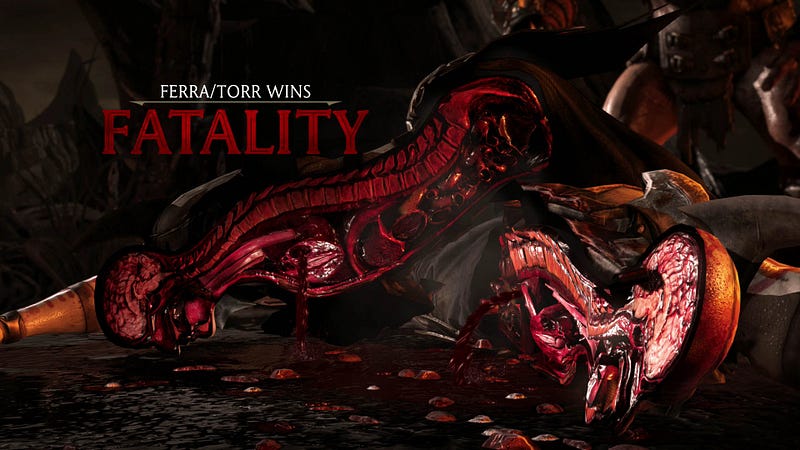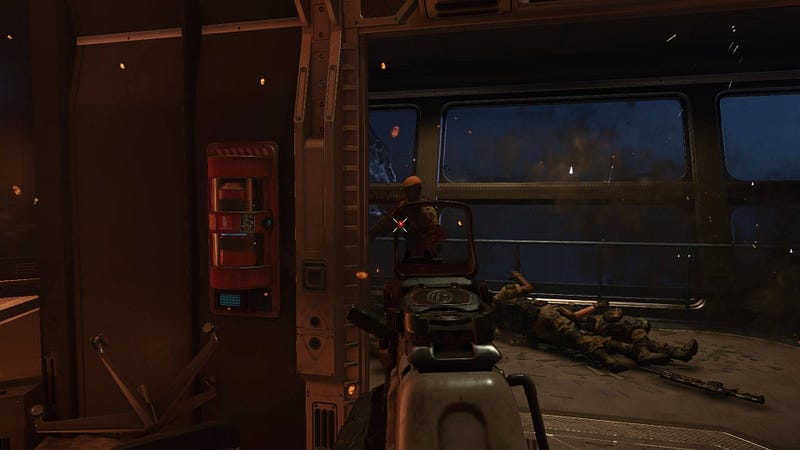Rated M for Minor
A look at why parents buy rated M games for their children.
Parents, it’s that time of year again. The holidays are here, and it’s time to get a move on your children’s Christmas list. It looks like the gift at the top of their list is that “hot new toy” that all of their friends seem to already have. You’ve jotted down the name of the toy, and made a note to stop at the nearest retailer to purchase one. You arrive at the front counter, take outyour list and point to the title you scribbled down earlier.
“I need this!” you tell the employee, seeming harried, rushed, even slightly desperate for this toy.
Before ringing you up, the employee informs you, “With this toy, your child will be able to partake in strong sexual content and nudity such as sex with prostitutes. He or she will also be able to enjoy intense violence by murdering that prostitute or anyone else walking down the street, without ramifications. Also, this toy allows your child to torture another human being until they talk or die. Then there is the use of drugs and alcohol where your child will be able to get drunk and or high and pilot any commercial vehicle available to them. Is that ok?”
“Yea, that’s fine,” you say. “They see that stuff anyways when they walk outside.”
Wait, what?

The gaming industry has been around for decades now. As the people playing the games have grown up and matured, so to has the type of games that are developed.
As an employee at an electronic retail chain, it is my job to play the role of the messenger to make sure that the parent has sufficient information about games they are about to purchase for their kids that are rated M for mature.
The video games of today’s market are subject to a ratings system in a similar fashion to that of films. While movies are rated by the Motion Picture Association of America, the Entertainment Software Rating Board distributes ratings to each video game made, based on the content found within each game. These ratings, as are listed on the ESRB website, are meant as a reflection of the level of maturity that the ESRB recommends players be before playing the game.
To purchase a rated M for mature game, you must show identification that proves that you are 17 years or older. There are many games that are rated M for mature, many of which are being played by children as young as 5.
These rated M games, games like Grand Theft Auto, Mortal Kombat, and Call of Duty, posses seriously graphic content and heavy themes that are displayed throughout the story.
The ESRB came about in 1994 after parents and advocacy groups became concerned with the games that were coming out and the ease of purchase availability to children. Just like with other forms of media, when more mature video games first came out parents were concerned that their children’s minds could be influenced by the video games they were consuming.

They aren’t wrong. According to a study done by the American Psychological Association on gamer behavior that was published this year, “The research demonstrates a consistent relation between violent video game use and increases in aggressive behavior, aggressive cognition and aggressive affect, and decreases in pro-social behavior, empathy and sensitivity to aggression.”
To be clear, they aren’t saying that playing these games turn you into a criminal psychopath. “Scientists have investigated the use of violent video games for more than two decades but to date, there is very limited research addressing whether violent video games cause people to commit acts of criminal violence,” said Mark Appelbaum, task force chair on the study.
But it is clear that there is a level of influence that is inherent with this type of media. Which is why the ESRB created a rating system; as a response to the outcry over video games, the rating scale was meant to help better inform parents so that they could make the decision of whether or not to buy these types of games for their children.

Video games share the same freedom as film, music, and other forms of art; and developers are therefore allowed to make games as graphic as they see fit. Yet is important to remember that rated M for mature games are made specifically for adults and as ESRB has done their part, by reviewing and rating the game in order to keep everyone informed, the ball for the final decision of whether or not it is appropriate for your child is left squarely in the hands of the parents.
Micheal Moreno, 39, said that even though he does recognize that much of the content in games like Call of duty is inappropriate for children, he still continues to purchase them for his own kids.
“Yes. I think it is a big deal despite buying my kids these games. Obviously we don’t approve of cussing. So to purchase a game with cussing almost conflicts with how we want to raise out kids.”
Moreno reasons that because his children could hear curse words from anywhere as it is prevalent in today’s speech, the real issue is not whether or not the child hears the words so much as whether they know that it is inappropriate for them to do it.
“They have to know what’s right and what is wrong. Just because someone else does it, doesn’t mean that they can say it. We just teach our kids to be bigger than that.”

Jim Rengazo, 55, was also shopping in the store with his son when he shared a similar sentiment. His son Tyler, 11, also plays Call of Duty. Rengazo is fine with his child playing these kinds of games.
“Basically, he is going to see it all anyway. His mom doesn’t like it, but I don’t think it’s a big deal,” said Rengazo.
Working within this industry, I get this response often. Customers come in to purchase the latest Call of Duty game for their children who are sometimes no more than 8 years old. I notify them that the game is rated M for mature for blood and gore, drug reference, intense violence, and strong language.
Their response is almost always the same, “It’s fine, my kids see that when they walk outside anyway.” As the games in question often simulate death, war, blood, sex and other really gruesome scenarios, I’ll sometimes ask, “My god, where do you guys live? It sounds like you guys are in extreme danger!”
Normally the customer laughs, realizing that their assertion is stretching reality more than just a bit, but then they pay for the game and hand it over to their child. However, parents’ assumption that their children will be exposed to this content one way or another seems to be one of the major driving forces behind why they purchase these games for their children in the first place.
Ronnie Silva, a 22-year-old assistant manager at Gamestop, watches as parents buy these games, almost without any sort of concern, consistently.
“Parents pretty much buy whatever games their kids want,” said Silva.
“I’ve noticed the only parents that say no are usually of an older generation. They tend to look at the content a little more. Some of the younger parents seem to not care about the ratings now a days.”
To be fair, even with the warning labels on the boxes, it can be hard to judge these games by their covers. The rating is found in a tiny corner of the box in the front and back. But at the end of the day, to a parent the rating just seems to be nothing more than a letter on a box. They probably never even see the graphic content that resulted in that letter. It’s not real to them because it exists only virtually.
But if the content of the game was imagined as a toy, a physical product that did all of the things a child is allowed to do in the game, perhaps parents might not be so quick to dismiss the rating as just a letter.
Imagine a child asking for an action figure that can shoot toys with bullets that actually causes other toys to explode, resulting in actual carcasses and bags with blood and guts. This super cool action figure also comes complete with functioning body parts like maneuverable genitals which allows your child to simulate sex with barbie. Included in the packaging, is a tiny handgun, a bag of cocaine, and several bottles of tequila.
That in a nutshell is what a person can simulate in games like Call of Duty and Grand Theft Auto. Yet because parents aren’t sitting with their children and watching them play these games, they aren’t really ever faced with how much of the game contains this extremely graphic, adult content.
It is not always a matter of ignorance though. Raul Ramirez, a concept artist for the Kingdom Heart franchise, has an young daughter that prefers her mom’s Batman Arkham Knight game to her Lego Batman game. As he is a part of the gaming industry, Ramirez doesn’t have the go-to logic that other parents do in explaining away their decision due to a lack of knowledge. Instead, he reasons that the key to children playing these games has more to do with the setting and context, as opposed to just the content.
“I have an issue with modern day themes and settings. So I wouldn’t get her something like Grand Theft Auto or anything Call of Duty. But with things like medieval and fantasy, I don’t have as big of an issue. Which is kind of weird. But I feel like modern day is a setting you can place yourself in,” Ramirez said.

For Ramirez, modern settings like the one in Grand Theft Auto V makes it easier for the player to see themselves in the shoes of the character. Games that are set in a fantasy world or take place in the past, make it harder to do that and despite having a similar violent and graphic nature, for Ramirez, the fantasy setting makes it more acceptable.
What is most concerning, however, is not an absence of concern or even a complete ignorance. Rather what is most frightening is that parents know and are informed of the content and yet they go against their parental instincts out of apathy, enabling their children to play games meant for adults.
Rather than pretending as though they have no control over the matter, as the primary consumers of this product, parents need to recognize that it is entirely within their power to select the types of games they allow their children to play with.
So seriously, before you go out and buy your 8-year-old son the new Call of Duty: Black Ops III game that he’s been dying for, please research the rating. Inform yourself of what exactly your child will be seeing, and ask yourself if you would buy your child an action figure that could do those things.














